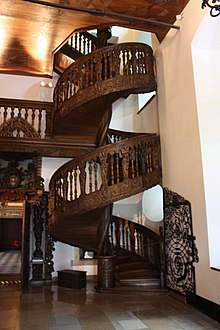Description[edit]
Loretto Chapel is best known for its "miraculous" spiral staircase, which rises 20 feet (6.1 m) to the choir loft while making two full turns, all without the support of a newel or central pole. The staircase is built mostly out of wood and is held together by wooden pegs, with no glue, nails or other hardware used. The inner stringer consists of seven wooden segments joined together with pegs, while the longer outer stringer has nine segments. The exact wood used to build the staircase is unknown, although it has been confirmed to be a type of spruce, non-native to New Mexico, and scientifically not identified anywhere else in the world. [7]
The handrails were added later, in 1887. The staircase does not actually stand by itself: Joe Nickell identified the inner wood stringer as well as an iron bracket attached to a column as supporting the staircase. [8][9]
Apart from any claims of its miraculous nature, the staircase has been described as a remarkable feat of woodworking. According to a Washington Post column by Tim Carter:
According to another professional carpenter, who was interviewed by Ben Radford for his book Mysterious New Mexico:
Similar stairs[edit]
Although the design of the Loretto stairs is highly unusual, other spiral staircases without center supports are known to exist. One example can be found at the Old Washoe Club in Virginia City, Nevada, which also dates to the 1870s. This staircase was described by Ripley's Believe It or Not! as "the longest of its kind without a supporting pole", although it has fewer turns than the Loretto staircase.[7]
Further afield, another staircase is in the Gdańsk Town Hall in Poland, which was reported to the New Mexican in 1944 by a government official named Bonnie Foster. The paper wrote:

No comments:
Post a Comment